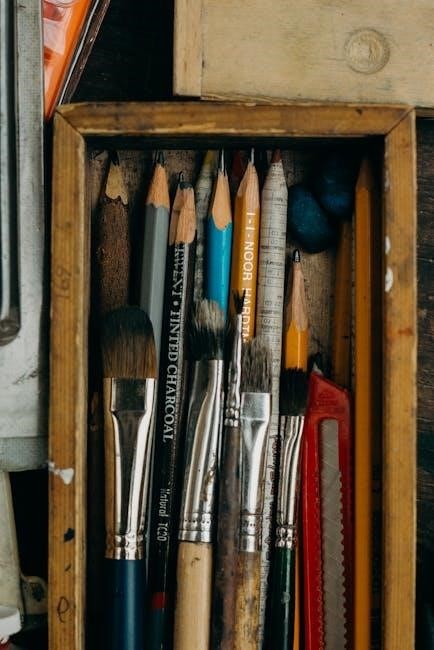Welcome to the LaserGRBL Manual‚ your comprehensive guide to mastering laser engraving with the LaserGRBL software and hardware․ This manual covers installation‚ safety‚ interface navigation‚ and advanced features to ensure safe and effective use of your laser engraver․ Whether you’re a beginner or an experienced user‚ this guide provides detailed instructions and troubleshooting tips to help you achieve professional-quality engravings․
1․1 Overview of LaserGRBL Software
LaserGRBL is a powerful software designed for controlling laser engravers‚ particularly those using the GRBL firmware․ It offers a user-friendly interface for managing laser operations‚ including G-code file handling‚ image processing‚ and machine control․ The software supports features like raster image import‚ grayscale conversion‚ and vectorization‚ making it versatile for both engraving and cutting tasks․ With its intuitive design‚ LaserGRBL is ideal for beginners and experienced users alike‚ providing step-by-step guidance for precise and safe laser operations․
1․2 Importance of the Manual for K40 Laser Engravers
This manual is essential for K40 laser engraver owners‚ providing detailed guidance on optimizing their machine with the LaserGRBL software․ It covers installation‚ configuration‚ and operation‚ ensuring safe and efficient use․ The manual addresses specific needs of K40 users‚ offering tailored solutions for common challenges․ By following the guide‚ users can unlock advanced features‚ improve engraving quality‚ and maintain their equipment effectively‚ making it an indispensable resource for achieving professional-grade results with their laser engraver․

Safety Guidelines
Always wear laser safety goggles and ensure proper ventilation․ Avoid direct laser exposure to skin or eyes․ Keep a fire extinguisher nearby and follow material safety guidelines․
2․1 General Safety Precautions
Always wear laser safety goggles to protect your eyes from harmful beams․ Avoid direct exposure to the laser‚ as it can cause severe burns and eye damage․ Ensure proper ventilation to prevent inhaling fumes․ Keep a fire extinguisher nearby and maintain a safe distance from flammable materials․ Never operate the laser without proper training․ Ensure the machine is placed on a stable‚ heat-resistant surface․ Follow all safety guidelines to minimize risks and ensure a safe working environment․
2․2 Laser-Specific Hazards and Protection
Always wear laser safety goggles to protect your eyes from harmful beams․ Direct exposure can cause severe burns and vision loss‚ even at low power․ Reflected beams are equally dangerous‚ so ensure your workspace is clear of reflective surfaces․ Proper training is essential before operating the laser․ Users must be at least 13 years old to operate the engraver․ Adhering to these precautions minimizes risks and ensures a safe working environment․
2․3 Fire and Material Safety
Always keep a fire extinguisher nearby when operating the laser engraver․ Ensure the workspace is free from flammable materials and well-ventilated to prevent fume buildup․ Never leave the machine unattended during operation․ Be cautious with materials that emit harmful fumes or catch fire easily․ Proper material handling and a clean environment are essential to minimize fire risks and ensure safe engraving sessions․
Installation and Setup
Welcome to the Installation and Setup section․ This guide will walk you through downloading and installing the LaserGRBL software‚ updating firmware‚ and setting up the LX4s board for your laser engraver․
3․1 Downloading and Installing LaserGRBL Software
To begin‚ visit the official LaserGRBL website and download the latest version of the software․ Ensure you select the correct version for your operating system․ Run the installer and follow the on-screen instructions to complete the installation․ Make sure your system meets the minimum requirements for smooth operation․ After installation‚ restart your computer to ensure all drivers and components are properly initialized․ For detailed guidance‚ refer to the installation guide․
3․2 Hardware Installation: LaserGRBL LX4s Board
Install the LaserGRBL LX4s board by first powering off your laser engraver․ Disconnect the old controller and carefully connect the LX4s board to the machine․ Ensure all wires are securely attached to the correct terminals․ Mount the board in a safe‚ accessible location․ Reconnect the power supply and test the machine to confirm proper functionality․ Refer to the hardware installation guide for detailed diagrams and step-by-step instructions to avoid errors during setup․

User Interface Overview
The LaserGRBL interface is intuitive and feature-rich‚ designed for easy navigation․ It includes key components like control buttons‚ preview panels‚ and customizable menus to enhance productivity and user experience․
4․1 Navigating the LaserGRBL Interface
The LaserGRBL interface is designed to be user-friendly and intuitive․ Upon opening‚ you’ll find a clear layout with control buttons‚ preview panels‚ and customizable menus․ The main screen displays essential tools for connecting to your engraver‚ loading G-Code files‚ and adjusting settings․ Use the toolbar to access features like jogging controls‚ speed overrides‚ and material settings․ The interface also provides real-time feedback‚ ensuring precise control over your laser engraver․ Customization options allow you to tailor the interface to your workflow‚ enhancing efficiency and productivity․
4․2 Key Components and Features
The LaserGRBL interface includes essential components like the G-Code preview panel‚ control buttons for jogging‚ and adjustable settings for power and speed․ Key features include real-time feedback‚ customizable buttons‚ and advanced overrides for precise control․ The software also supports raster image import and conversion‚ enabling detailed engravings․ Additional tools like material parameter presets and engraving mode selection enhance functionality‚ making it versatile for various projects․ These features ensure efficient and accurate laser engraving operations․
4․3 Customizing the Interface
The LaserGRBL interface allows for extensive customization to suit your workflow․ Users can add custom buttons‚ modify themes‚ and rearrange panels for easier access to frequently used tools․ Additionally‚ shortcuts can be assigned to specific functions‚ enhancing productivity․ The software also supports drag-and-drop functionality for quick access to files and settings․ These customization options enable users to tailor the interface to their preferences‚ improving efficiency and overall user experience during engraving projects․
Connecting to the Engraver
Connecting your laser engraver to LaserGRBL involves setting up communication between the software and hardware․ Ensure the engraver is properly configured and connected via the appropriate interface․ Follow the software prompts to establish a stable connection‚ enabling seamless control and operation of your engraving machine․
5․1 Setting Up the Connection
To establish a connection in LaserGRBL‚ select the correct COM port corresponding to your engraver․ Ensure the baud rate matches the firmware settings․ Click “Connect” to initialize communication․ Once connected‚ test the laser’s responsiveness using jog controls․ Always verify the connection before sending G-code files to avoid errors․ A stable connection ensures precise control over the engraver’s movements and settings‚ enabling accurate and efficient engraving operations․ Proper setup is crucial for safe and effective laser engraving․
5․2 Configuring GRBL Firmware
Configuring the GRBL firmware is essential for optimal performance․ Access the firmware settings via the console in LaserGRBL․ Adjust parameters like step size‚ acceleration‚ and laser power limits to match your engraver’s specifications․ Ensure settings align with your machine’s capabilities for precise control․ Incorrect configurations can lead to errors or damage․ After adjustments‚ save the settings to ensure persistence across sessions․ Proper firmware setup ensures smooth operation and enhances engraving quality․ Always refer to your engraver’s documentation for specific configuration guidelines․

Loading and Sending G-Code Files
Loading and sending G-Code files is a critical step in the laser engraving process․ Use LaserGRBL to import G-Code files‚ preview designs‚ and send them to your engraver․ Ensure the file is compatible with your machine’s settings before sending․ Always wear safety goggles and verify parameters to avoid errors during execution․
6․1 Understanding G-Code Files
G-Code files are text-based instructions that guide your laser engraver’s movements‚ power levels‚ and operations․ They are essential for precise engravings and cuts․ LaserGRBL supports G-Code files‚ allowing you to import‚ preview‚ and execute designs․ Each line of code represents a specific command‚ such as moving to a coordinate or adjusting laser power․ Understanding G-Code basics helps optimize your engravings and troubleshoot issues․ Always ensure compatibility with your machine’s settings before sending files to the engraver․
6․2 Sending Files to the Engraver
To send G-Code files to your engraver using LaserGRBL‚ connect your machine via the software interface․ Upload the G-Code file by clicking the “Load” button and selecting the file․ Preview the design to ensure accuracy․ Adjust settings like speed and power if needed․ Click “Send” to start the engraving process․ Always ensure the laser is properly calibrated and the material is secure before beginning․ Use the preview feature to verify the design aligns with your material dimensions for precise results․

Image Import and Processing
The LaserGRBL software supports importing raster images for engraving․ It converts images into grayscale or uses dithering for optimal results․ Vectorization tools are also available for precise cuts․
7․1 Importing Raster Images
LaserGRBL allows users to import raster images in formats like BMP‚ JPG‚ and PNG․ Once imported‚ images are converted into grayscale or dithering patterns for engraving․ The software automatically adjusts brightness and contrast to optimize the engraving process․ Users can preview the raster image before sending it to the engraver‚ ensuring accurate results․ This feature is essential for creating detailed engravings on various materials‚ making it a versatile tool for both beginners and experienced users․
7․2 Grayscale and Dithering Conversion
LaserGRBL supports grayscale and dithering conversion for raster images‚ enhancing engraving quality․ Grayscale conversion adjusts pixel brightness for smooth transitions‚ while dithering uses patterns to simulate shades․ These methods optimize laser performance‚ ensuring detailed engravings on materials like wood and metal․ Proper conversion settings are crucial for achieving desired results‚ making this feature indispensable for precise and professional outcomes․
7․3 Vectorization of Images
LaserGRBL offers robust tools for vectorizing raster images‚ converting them into scalable vector graphics․ This process is essential for precise cutting and engraving․ The software uses advanced algorithms to detect edges and create accurate vector paths․ Vectorization ensures smooth lines and curves‚ making it ideal for intricate designs․ Users can adjust settings like thresholding and smoothing to optimize results․ This feature is particularly useful for creating clean‚ professional outputs‚ making it a cornerstone of the LaserGRBL workflow for both beginners and experienced users․

Engrave and Cut Settings
LaserGRBL allows precise control over engraving and cutting parameters‚ including power‚ speed‚ and depth․ These settings ensure optimal results for various materials‚ enhancing accuracy and efficiency in projects․
8․1 Configuring Power and Speed Settings
Configuring power and speed settings in LaserGRBL is essential for achieving precise engravings and cuts․ Adjust the laser’s power based on material thickness and type‚ ensuring optimal results without damage․ Speed settings control the engraver’s movement‚ balancing quality and efficiency․ Higher power levels are suitable for denser materials‚ while lower settings are ideal for delicate surfaces․ Always test settings on scrap material before final projects to ensure accuracy and safety․
8․2 Advanced Parameters for Precision
For enhanced precision‚ LaserGRBL offers advanced parameters like pulse width modulation (PWM) and frequency adjustments․ These settings refine the laser’s output‚ ensuring consistent power delivery and minimizing material damage․ Adjusting the PWM frequency can optimize engraving quality for specific materials‚ while fine-tuning acceleration and jerk settings improves machine accuracy․ Experiment with these parameters to achieve smoother cuts and detailed engravings‚ especially for intricate designs or sensitive materials․ Always test advanced settings on scrap material before final projects․

Exporting G-Code Files
Exporting G-Code files in LaserGRBL is essential for transferring designs to your engraver․ Ensure settings like power‚ speed‚ and material parameters are correctly configured before exporting to guarantee accurate results․
9․1 Preparing Files for Engraving
Preparing files for engraving in LaserGRBL involves ensuring designs are compatible with your laser engraver․ Check that all settings‚ such as power‚ speed‚ and resolution‚ are correctly configured․ Verify material parameters to match your substrate‚ and ensure the file format is supported (e․g․‚ SVG‚ DXF)․ Review the design for any errors or inconsistencies before exporting the G-Code file for engraving․ Proper preparation guarantees precise and accurate results during the engraving process․
9․2 Exporting Settings and Options
Exporting settings and options in LaserGRBL allows you to save your configurations for future use or transfer to another machine․ Access the export menu to save your current settings‚ including power‚ speed‚ and material parameters‚ as a file․ Choose from various file formats like G-Code or CSV․ Ensure file names and locations are clear for easy retrieval․ This feature is essential for maintaining consistency across projects and streamlining your workflow when using the laser engraver․

Advanced Features
LaserGRBL offers advanced features like jogging controls‚ speed and power overrides‚ and custom buttons for enhanced machine control․ These tools enable precise adjustments and streamlined workflows during engraving projects․
10․1 Jogging and Machine Control
LaserGRBL allows precise control of your laser engraver through jogging features․ Use arrow keys or a joystick to manually move the laser head‚ ensuring accurate positioning before engraving․ This feature is ideal for aligning designs with material edges or adjusting the laser’s starting point․ Jogging enables users to test limits and avoid material waste․ With customizable speeds‚ you can achieve smooth‚ controlled movements‚ making it easier to refine your setup and achieve professional-quality results consistently․
10․2 Speed and Power Overrides
LaserGRBL offers real-time adjustments for speed and power during engraving‚ allowing users to optimize results based on material response․ This feature is particularly useful for fine-tuning intricate designs or adapting to varying material densities․ By overriding default settings‚ users can enhance precision‚ reduce burn marks‚ or increase efficiency․ The software provides clear controls for adjustments‚ ensuring seamless modifications without interrupting the engraving process․ This capability is essential for achieving consistent‚ high-quality outcomes in various laser engraving projects․
10․3 Custom Buttons and Shortcuts
LaserGRBL allows users to create custom buttons and shortcuts‚ streamlining workflow for frequently used commands․ This feature enhances efficiency by providing quick access to specific functions‚ such as jogging‚ pausing‚ or resetting the machine․ Users can assign personalized shortcuts to simplify complex operations‚ reducing the need for repetitive menu navigation․ Custom buttons can also be tailored to specific projects‚ making the software more adaptable to individual preferences and improving overall productivity during laser engraving tasks․

Troubleshooting Common Issues
Troubleshoot connection‚ software‚ and hardware issues with step-by-step guides․ Diagnose errors‚ resolve glitches‚ and optimize performance for smooth laser engraving operations using LaserGRBL․
11․1 Diagnosing Connection Problems
Identify and resolve connection issues between your computer and laser engraver․ Check USB connections‚ ensure proper driver installation‚ and verify GRBL firmware settings․ Use Windows troubleshooters for audio and device connections․ Restart the LaserGRBL software and engraver․ Consult the LaserGRBL manual for detailed troubleshooting steps․ If issues persist‚ refer to Microsoft support or community forums for additional guidance․ Ensure baud rate and COM port settings match your hardware configuration for reliable communication․
11․2 Resolving Software Glitches
Address software issues by restarting LaserGRBL and ensuring all updates are installed․ Check for compatibility with your operating system and firmware․ Clear cache and temporary files․ If glitches persist‚ reinstall the software or reset settings to default․ Refer to the LaserGRBL manual for troubleshooting guides․ For unresolved issues‚ visit Microsoft support or laser engraver community forums for assistance․ Regular updates and proper configuration are key to maintaining smooth software performance․
11․3 Addressing Hardware-Related Issues
Hardware issues with your laser engraver can often be resolved by checking connections and ensuring proper installation of the LaserGRBL LX4s board․ Verify that all cables are securely connected and that the firmware is up-to-date․ If problems persist‚ consult the LaserGRBL manual for troubleshooting steps or contact support․ Regular maintenance‚ such as cleaning components and updating drivers‚ can prevent hardware-related issues․ For complex problems‚ refer to community forums or professional assistance to ensure optimal performance and safety․

Maintenance and Upkeep
Regular maintenance ensures optimal performance and longevity of your laser engraver․ Clean the laser head‚ check mirrors‚ and ensure proper airflow․ Update firmware and drivers periodically for smooth operation․
12․1 Regular Maintenance Tips
Regular maintenance is crucial for optimal performance and longevity of your laser engraver․ Clean the laser head and mirrors frequently to ensure accurate beam alignment․ Check and replace worn-out belts or pulleys to maintain precise movement․ Ensure proper airflow by cleaning dust from fans and vents․ Regularly update the GRBL firmware and LaserGRBL software to access new features and improvements․ Always store the machine in a dry‚ cool environment to prevent damage․ Schedule periodic inspections to identify and address potential issues early․
12․2 Updating Firmware and Software
Regularly updating the GRBL firmware and LaserGRBL software ensures optimal performance‚ security‚ and access to new features․ Always download updates from official sources to avoid malware․ Before updating‚ back up your settings and ensure the machine is disconnected from power․ Follow the provided instructions carefully to avoid installation errors․ After updating‚ restart the system and verify functionality․ If issues arise‚ consult the troubleshooting section or contact support for assistance․ Keeping your system updated is essential for smooth operation and compatibility with new features․
Material Parameters and Settings
Material parameters are crucial for precise engraving and cutting․ The system offers default settings for various materials‚ which can be adjusted for specific requirements․
13․1 Understanding Material-Specific Settings
Material-specific settings are essential for achieving optimal results in laser engraving․ Different materials‚ such as wood‚ metal‚ and plastic‚ require unique power and speed configurations․ LaserGRBL provides default parameters for common materials‚ but these can be adjusted based on thickness‚ density‚ and desired outcomes․ Understanding these settings ensures precise control over the engraving process‚ preventing damage to materials and the machine․ Customizing settings allows for tailored results‚ enhancing the quality and safety of your projects․
13․2 Default Parameters for Common Materials
LaserGRBL provides default parameters for common materials like wood‚ metal‚ and plastic‚ ensuring optimal engraving and cutting results․ These settings‚ including power‚ speed‚ and frequency‚ are pre-configured based on material type and thickness․ Users can select engraving or cutting modes to automatically load appropriate settings․ While these defaults are a great starting point‚ they can be fine-tuned for specific projects‚ allowing for precise control and consistent outcomes․ This feature simplifies the process for both beginners and experienced users․
Mastering LaserGRBL ensures safe and effective laser engraving․ This manual guides you through setup‚ operation‚ and advanced features‚ helping you unlock your laser engraver’s full potential for professional results․
14․1 Summary of Key Points
This manual provides a comprehensive guide to using LaserGRBL software and hardware‚ covering installation‚ safety‚ interface navigation‚ G-code handling‚ image processing‚ engraving settings‚ and troubleshooting․ It emphasizes safety precautions‚ proper setup‚ and optimization of laser parameters for various materials․ The guide also includes tips for maintenance and advanced features to enhance your laser engraving experience‚ ensuring you achieve precise and professional results with your K40 or similar laser engraver․
14․2 Final Tips for Effective Use
For optimal results with LaserGRBL‚ always maintain your equipment‚ experiment with settings for materials‚ and use advanced features like custom buttons․ Regularly update firmware and software to access new functionalities․ Keep your workspace clean and well-ventilated to ensure safety and efficiency․ Practice on scrap material before final projects and refer to the manual for troubleshooting․ By following these tips‚ you can maximize the potential of your laser engraver and achieve professional-quality engravings consistently․